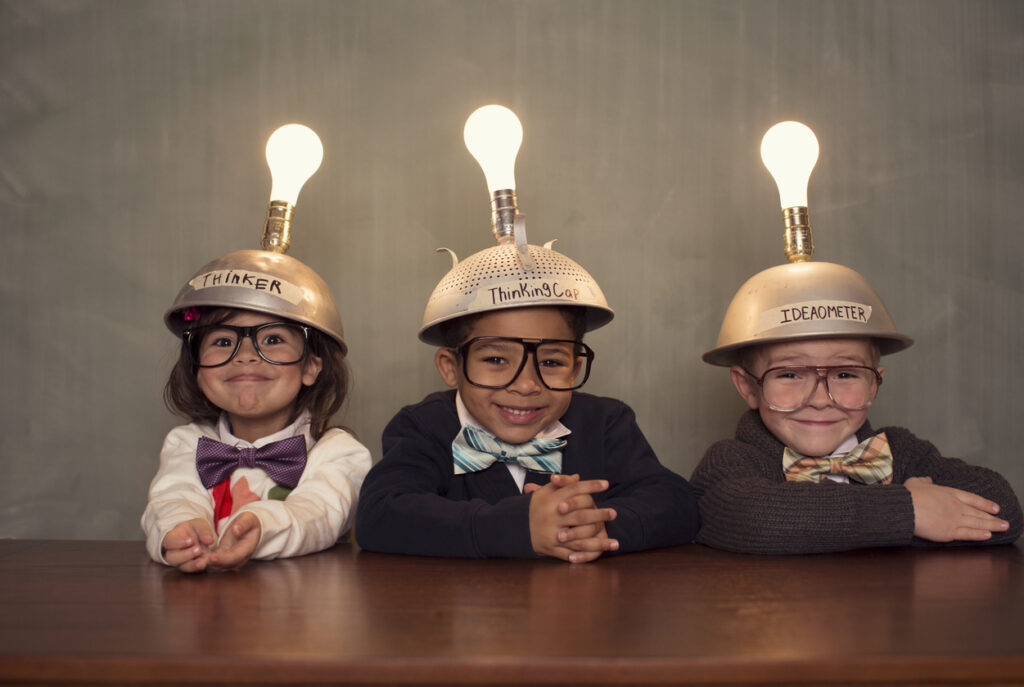People learn better when they look for or discover the answers for themselves rather than being given information.
This is because it requires them to use more parts of the brain, creating a ‘mental web’ of information associated with the required knowledge or skill, which helps them to store, retrieve, and use what they have learnt.
Even if learners are asked a question and they get the answer wrong, they will remember and recall the correct answer better than if they had just been given the answer in the first place.
How to promote a problem-solving mindset
- Begin with a thought-provoking question or prompt that encourages learners to explore the topic and the particular challenges that they face in relation to it.
- Create experiments – get different groups to carry out the same task under different conditions then compare results and identify what the results tell them.
- Create simulations of real situations using props, tools, movement, voices and anything else that comes to hand and ask learners to work out what it tells them.
- Use games and toys such as playing cards and construction toys (charity shops are a great source) and use them for training activities.
When we learn something new, the brain reorganises itself by forming new neural pathways.
- Create puzzles such as quizzes and crosswords with solutions that are relevant to the training topic.
- Give learners a problem or a topic to research and ask them to draw conclusions or generate theories themselves then present this to the group.
- When someone asks a question, ask learners what they think is the answer or ask them to go and find the answer themselves and share it with the group, rather than answering it yourself.
- Ask probing open questions such as “how could you use this information to …?” or “what would happen if.…?” or “what are the benefits of this?”
Rewiring the brain
When we learn something new, the brain reorganises itself by forming new neural pathways.
The more a network of neurons is activated, the stronger the connections become, and if particular neurons keep firing at the same time, eventually they develop a physical connection, which means that our brain links different experiences together (for example it may link a particular emotion with a particular situation).
We can even change our brains just by imagining doing something, because the brain doesn’t distinguish between real or imagined activity.
It’s easier to strengthen the beneficial neural pathways that learners already have than to create new ones from scratch.
By visualising doing something we can create the same physical changes in the brain as if we were doing it for real.
- Tell people that they can change their brain: people who believe that they can change their brain learn better than those who think their brain is fixed.
- Repeat, repeat, repeat: repetition helps build thicker, stronger, more hard-wired connections in the brain. Regularly recap and revisit the learning points in different ways through different types of learning activities.
- Build on existing pathways: it’s easier to strengthen the beneficial neural pathways that learners already have than to create new ones from scratch. Find out what learners already know or can already do then reinforce and build on this.
- Involve learners in creating mind maps, flow charts, 3D models or sculptures: when learners see relationships between concepts and experiences, they generate more neural activity and create stronger memories.
- Create opportunities for the unconscious mind to play with it has learnt: ask learners to walk away and do another task for at least 15 minutes after the learning activity.
- Use visualisations: the brain can’t tell the difference between something real or imagined, so use visualisations to help learners to mentally rehearse their new habits.
- Use metaphors, symbols, analogies and rituals: these devices (where one thing is used to represent another) enable our brain to process the representation as if it were the real thing, which strengthens the learning.
- Use positive affirmations: when learners say they are going to do something, neural pathways are formed which support that intention and they are then more likely to actually do it.
- Use anchors: external cues or stimuli, such as a colour, sound, or image can be associated with learning points to help learners create stronger memories which they can retrieve more easily.
- Use mindfulness activities and meditations: these enhance the areas of the brain associated with learning and memory, emotional regulation, and self-awareness, and inhibit the areas associated with fear, anxiety, and stress.
This is by no means an exhaustive list but hopefully these ideas will stimulate and inspire you to find your own ways of mentally engaging learners.
My next two articles will look respectively at how you can engage the heart and spirit of learners.
For more insights on this topic, read The holistic learning handbook: a practical guide for teachers and trainers by Nicki Davey, published by Jessica Kingsley Publishers in 2020.
People learn better when they look for or discover the answers for themselves rather than being given information.
This is because it requires them to use more parts of the brain, creating a ‘mental web’ of information associated with the required knowledge or skill, which helps them to store, retrieve, and use what they have learnt.
Even if learners are asked a question and they get the answer wrong, they will remember and recall the correct answer better than if they had just been given the answer in the first place.
How to promote a problem-solving mindset
- Begin with a thought-provoking question or prompt that encourages learners to explore the topic and the particular challenges that they face in relation to it.
- Create experiments - get different groups to carry out the same task under different conditions then compare results and identify what the results tell them.
- Create simulations of real situations using props, tools, movement, voices and anything else that comes to hand and ask learners to work out what it tells them.
- Use games and toys such as playing cards and construction toys (charity shops are a great source) and use them for training activities.
When we learn something new, the brain reorganises itself by forming new neural pathways.
- Create puzzles such as quizzes and crosswords with solutions that are relevant to the training topic.
- Give learners a problem or a topic to research and ask them to draw conclusions or generate theories themselves then present this to the group.
- When someone asks a question, ask learners what they think is the answer or ask them to go and find the answer themselves and share it with the group, rather than answering it yourself.
- Ask probing open questions such as “how could you use this information to …?” or “what would happen if.…?” or “what are the benefits of this?”
Rewiring the brain
When we learn something new, the brain reorganises itself by forming new neural pathways.
The more a network of neurons is activated, the stronger the connections become, and if particular neurons keep firing at the same time, eventually they develop a physical connection, which means that our brain links different experiences together (for example it may link a particular emotion with a particular situation).
We can even change our brains just by imagining doing something, because the brain doesn't distinguish between real or imagined activity.
It’s easier to strengthen the beneficial neural pathways that learners already have than to create new ones from scratch.
By visualising doing something we can create the same physical changes in the brain as if we were doing it for real.
- Tell people that they can change their brain: people who believe that they can change their brain learn better than those who think their brain is fixed.
- Repeat, repeat, repeat: repetition helps build thicker, stronger, more hard-wired connections in the brain. Regularly recap and revisit the learning points in different ways through different types of learning activities.
- Build on existing pathways: it’s easier to strengthen the beneficial neural pathways that learners already have than to create new ones from scratch. Find out what learners already know or can already do then reinforce and build on this.
- Involve learners in creating mind maps, flow charts, 3D models or sculptures: when learners see relationships between concepts and experiences, they generate more neural activity and create stronger memories.
- Create opportunities for the unconscious mind to play with it has learnt: ask learners to walk away and do another task for at least 15 minutes after the learning activity.
- Use visualisations: the brain can’t tell the difference between something real or imagined, so use visualisations to help learners to mentally rehearse their new habits.
- Use metaphors, symbols, analogies and rituals: these devices (where one thing is used to represent another) enable our brain to process the representation as if it were the real thing, which strengthens the learning.
- Use positive affirmations: when learners say they are going to do something, neural pathways are formed which support that intention and they are then more likely to actually do it.
- Use anchors: external cues or stimuli, such as a colour, sound, or image can be associated with learning points to help learners create stronger memories which they can retrieve more easily.
- Use mindfulness activities and meditations: these enhance the areas of the brain associated with learning and memory, emotional regulation, and self-awareness, and inhibit the areas associated with fear, anxiety, and stress.
This is by no means an exhaustive list but hopefully these ideas will stimulate and inspire you to find your own ways of mentally engaging learners.
My next two articles will look respectively at how you can engage the heart and spirit of learners.







